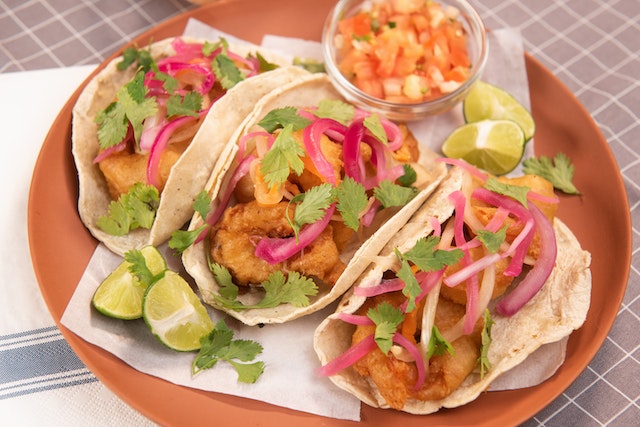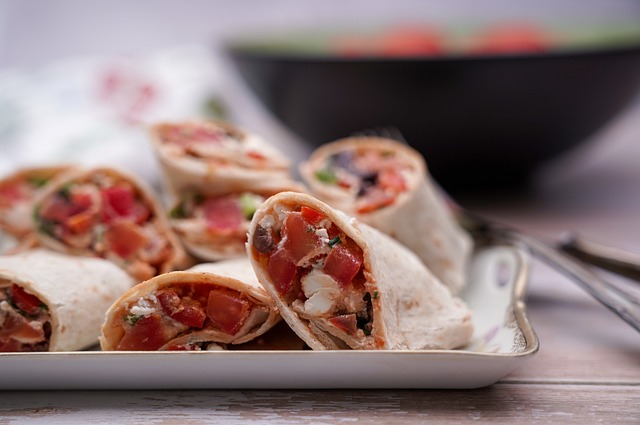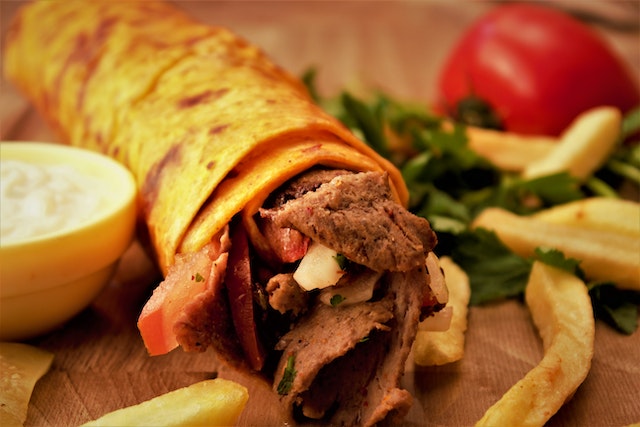When deciding what to have for lunch, two classic sandwich options that come to mind are a tortilla wrap or a regular wrap. Wraps can be made with either tortilla vs wrap and each offers distinct advantages when it comes to convenience, taste, health benefits and preparation. Whether you’re looking for an easy lunchtime meal or something more substantial in the evening, understanding the differences between tortilla vs wrap can help you make the right choice for your lifestyle. Let’s explore how tortilla wraps compare to regular wraps – because knowing is half the battle!
Table of Contents
What Is Tortilla?
Tortilla is a traditional Mexican flatbread that dates back thousands of years and is made from ground maize. It is a staple in Mexican cuisine, used in dishes like tacos, burritos, quesadillas and many more. Tortilla can be made with either yellow or white cornmeal and are cooked on a hot griddle or clay disk called a comal. The resulting tortillas have a soft texture, similar to pita bread but thinner.
One of the things that makes tortilla so special is its versatility; it can be enjoyed as an accompaniment to savory dishes, as the main ingredient for dishes like tacos, or served sweet by adding ingredients like honey or cinnamon sugar. Tortilla can also be used as wraps for sandwiches, egg scrambles and even desserts.
Tortillas are incredibly popular not only in Mexico but around the world. They are sold in stores both fresh and pre-packaged, and they have become an integral part of Latin American cuisine today. Not to mention they’re a great source of complex carbohydrates which help provide energy to fuel you throughout the day!

How Are Tortillas Made?
Tortillas are a type of flatbread that has been enjoyed throughout Central and South America for centuries. Though the recipe may vary from region to region, the classic tortilla is made with flour and water, salt, and fat (lard or shortening). The dough is then rolled out and cooked on a griddle or comal, giving the tortilla its signature shape.
The process begins by making the dough. A basic homemade version requires three ingredients: all-purpose flour, water, and salt. When these ingredients are combined together in a bowl they form a stiff dough that can be kneaded into a ball. Before rolling out the dough, it should be left to rest for 30 minutes so it can become easier to work with.
Once the dough has rested, it needs to be divided into small balls – usually about 50g each – which will then be rolled out using a rolling pin on a floured surface until they are thin and round. To ensure an even thickness across each tortilla, many people use a specific kitchen tool called a tortillero (or roughly translated “tortilla press”) which is like two pieces of wood hinged together with handles on either side that flatten out the balls of dough when pressed down at once.
Next step is cooking the tortillas on a hot griddle or comal – this is what gives them their distinctive texture and flavour – depending on how thick you made them earlier they should cook for 1-2 minutes per side until golden brown spots appear. Once cooked through you can set aside to cool before serving.
Finally, if you wish to add some extra flavour to your homemade tortillas you have several options available; lard or vegetable shortening is often added during the kneading process as well as herbs such as dried oregano or paprika – both of which give an amazing depth of flavour to your freshly made tortillas! You could also add some cheese like crumbled queso fresco when rolling out your balls of dough for extra richness – yum!
Making homemade tortillas may sound complicated but in truth it’s relatively simple – all you need is flour, water, salt and fat (lard or vegetable shortening) plus some patience in order to roll out perfect rounds every time! With just these few key ingredients you can create something truly special – tasty warm homemade fresh-from-the-griddle tortillas that will brighten up any meal!
What Is Wraps?
Wraps are a popular and versatile type of cuisine that is quickly gaining in popularity. It refers to a burrito-like dish made with ingredients such as meats, vegetables, and condiments all rolled together in a soft flatbread like flour tortilla. They can be served hot or cold, making them incredibly convenient for on-the-go eating.
Wraps are usually seen as healthier alternatives to traditional fast food meals because they offer a much wider range of ingredients that often include nutritious items such as lean meats, healthy grains, fresh vegetables, and low-fat sauces. By carefully selecting the right ingredients for your wrap, you can create an extremely healthy meal that is high in protein and low in saturated fat.

They also offer a great way to get creative with your culinary skills and try out new combinations of flavors; from classic dishes like chicken Caesar wraps to inventive fusion recipes such as Thai peanut pork wraps. As wraps have become more popular, restaurants all over the world have started offering their own unique versions – so no matter where you are there is sure to be an exciting wrap option available nearby.
What really makes wraps stand out though is their portability; they make perfect lunches for work or school since they don’t require any utensils or dishes aside from the wrap itself. Wraps are also great for picnics and camping trips since they travel well without becoming soggy or falling apart; just pack them up and take them wherever you go!
So if you’re looking for a delicious yet healthy meal that is easy to make and enjoy on the go – then look no further than the humble wrap! Whether you’re in the mood for something classic or adventurous, there’s sure to be something perfect for everyone’s palate wrapped up inside these delectable parcels of flavor!
How Are Wraps Made?
Wraps are a great sandwich alternative that can offer a light and flavorful meal any time of day. They are also a great way to use up leftovers from the night before. Making wraps at home is incredibly easy and requires minimal ingredients.
First, start by gathering your wrap ingredients. Depending on your taste preference, you can mix and match different types of meats, cheeses, vegetables, sauces and spreads. Popular combinations include turkey and Swiss with lettuce, tomato and honey mustard sauce; grilled chicken with mozzarella cheese, roasted red peppers and basil pesto; or turkey burger with pepper jack cheese, avocado slices and ranch dressing. Other classic combinations include ham and cheddar cheese with lettuce and mayonnaise or tuna salad with hard-boiled egg slices and dijon mustard sauce.
Once you have your ingredients ready to go, you’ll need to prepare the wrap itself. Start by laying out a large piece of flatbread such as naan or a tortilla shell on a clean plate or cutting board. Then spread one side of the wrap with your choice of condiment or spread such as mayonnaise, hummus or olive tapenade. This will help keep all the other ingredients in place once it’s rolled up into the wrap shape.
Next layer on the meat or other protein source followed by cheese slices — if desired — then top it off with freshly cut vegetables such as tomato slices, lettuce leaves, cucumber strips or sprouts for extra crunchiness. Finally drizzle any additional sauces over everything before rolling it up into a tight cylinder shape using two hands – be careful not to overfill it so it’s easier to roll! Secure the ends with toothpicks so it keeps its shape while eating if necessary.
Now that your wrap is made, you can either eat it right away while still warm (if you chose to grill your proteins) or pop it in the fridge for later in an airtight container for up to 3 days! Enjoy your homemade wrap – no matter what combination you choose – as a quick snack in between meals or as an entire meal when paired with a side salad or chips!

Tortilla Vs Wrap Comparison
Tortillas and wraps often get confused, as they are both thin flatbreads used to hold various ingredients together. However, their differences are significant.
Tortillas are made from masa harina flour, which is a dough made from ground corn that has been treated with lime or an alkaline solution. This gives them a distinct flavor and texture that makes them perfect for Mexican dishes like tacos, burritos, and quesadillas. Wraps, on the other hand, are usually made from wheat flour and can be flavored with spices. They have an earthier taste and are more suited for sandwiches.
In terms of size, tortillas tend to be larger than wraps. This means that they work better for wrapping around ingredients without needing to overlap them too much. Wraps are typically smaller and are better suited for creating layered sandwiches as they can fold around ingredients neatly without leaving any filling exposed.
Nutritionally speaking, tortillas generally provide fewer calories compared to wraps although this can depend on the specific brand you choose. Tortillas may also contain more fiber due to their corn base while wraps usually contain more protein thanks to the wheat flour they use in their preparation.
In terms of versatility, tortillas are great for making tacos and burritos as mentioned above but they can also be used as a wrap substitute in other dishes such as enchiladas, stuffed peppers or even pizza crusts! Wraps however tend to be more versatile when it comes to sandwich-type meals as well as rolled appetizers like spring rolls or egg rolls.
Overall both tortillas and wraps offer great alternatives for different food preparations depending on your preference of taste or texture and your nutritional needs. So when deciding between the two it’s important that you consider all these factors to decide which one best suits your needs!
What Kind Of Tortilla Is Used For Wraps?
When it comes to tortillas used for wraps, there are a variety of different types available. Corn tortillas are the traditional favorite when making Mexican-style dishes such as tacos and burritos, but flour tortillas are becoming increasingly popular for wraps as well. Both types of tortilla offer a soft, pliable texture that’s ideal for holding the ingredients together without breaking apart.
Corn tortillas are made from ground corn and are usually lightly cooked on a griddle or skillet before being filled with whatever ingredients you want. Flour tortillas, on the other hand, use wheat flour as the base ingredient and they come in both white and whole wheat varieties. While they are similar to corn when it comes to their wrapping capabilities, they have a milder taste which makes them ideal for many different types of wraps.
Regardless of which type of tortilla you’re using for your wrap, always make sure it is thoroughly heated before adding ingredients. This will help ensure that all your fillings stay put and that your wrap stays held together nicely. Another way to keep your wrap from coming apart is to double up on your ingredients so that you can use two layers of the same filling instead of just one single layer.
Finally, keep in mind that not all tortillas are created equal – those made with preservatives or artificial flavors can give off an odd flavor so always look for ones labeled “natural” if you want to maintain the taste of your original ingredients. Whether you choose corn or flour, both types of tortilla make an excellent base for delicious wraps that everyone can enjoy!
>>> See more:
Best deep fryer consumer reports
FAQs About Tortilla Vs Wraps
What Is The Difference Between A Tortilla And A Wrap?
A tortilla is a thin, unleavened flatbread that is made from corn or wheat flour. They are usually round in shape and can come in many sizes, including small for tacos to large for burritos. A wrap, on the other hand, is a type of sandwich consisting of various ingredients rolled in a flatbread such as a tortilla. Wraps often contain vegetables, proteins such as chicken or beef, sauces, cheeses, and other condiments.
What Are The Benefits Of Eating Tortillas Vs Wraps?
Tortillas offer several health benefits due to their high fiber content. Fiber helps keep you fuller longer and aids digestion. Additionally, they’re relatively low calorie and make a great nutritious alternative to bread or crackers when used to make sandwiches or wraps. Wraps are also typically lower in calories compared with other traditional sandwich options due to the lack of bread. Additionally, they provide an easy way to enjoy your favorite fillings without having to worry about loading up on extra carbs from bread.
Are Wraps Healthier Than Tortillas?
It really depends on what type of fillings you choose for your wrap or taco versus what kind of tortilla you select. Some store-bought tortillas can have added fats like shortening which add additional calories and fat content that may not be desired for those trying to watch their weight or overall health goals. Going for whole wheat or whole grain versions will ensure you’re getting more nutrients from your meal while still enjoying all the flavors of tacos or burritos. On the flip side, some wraps contain higher levels of sugar than others so if you’re looking for something healthier it’s always best to check labels or inquire about ingredients at restaurants before ordering any wraps.
Which One Is Better Suited For Different Types Of Meals?
Tortillas are most commonly used as an ingredient in Mexican cuisine such as tacos and burritos but there are tons of creative ways you can use them around the world such as making quesadillas and enchiladas. Wraps meanwhile can be filled with almost anything since they don’t have quite as much flavor on their own like a flavored tortilla would have so they pair well with cold cuts, vegetables, and sauces like hummus or avocado cream sauce making them perfect lunchtime meal options when paired with some fresh greens on the side!
>>> See more: Chicken Wrap, Quick And Easy Recipe By Recipes of the World
Conclusion
While both tortilla vs wrap can make delicious and convenient meals, it’s important to know the difference between the two. Tortillas are made with flour or corn while wraps are usually made with wheat. Flour tortillas are soft and light while corn tortillas are a bit thicker and chewy. Wheat wraps tend to be thinner than both types of tortillas.
When choosing between a tortilla and wrap, think about what kind of consistency you prefer in your food as well as what type of ingredients you’ll be using. If you want a softer option that will complement delicate flavors, go for a flour tortilla. If you’re looking for something heartier that can stand up to bolder ingredients, choose a corn tortilla or wheat wrap.
Cafe Toscana Restaurant is a blog about food, drinks, and recipes. Our focus is on simple, healthy, and delicious recipes that anyone can make. We also love to talk about food culture, food news, and anything else related to the world of food.

